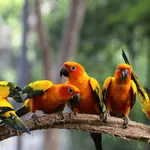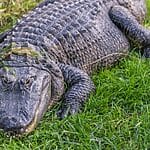Discover the extraordinary abilities of animals with webbed feet, a key evolutionary feature for survival in diverse habitats. From gliding albatrosses to stealthy alligators, these creatures’ unique adaptations offer a glimpse into nature’s ingenuity.
Uncover the critical role webbed feet play in hunting, mating, and ecosystem health, and learn why their conservation is essential.
Key Takeaways:
- Webbed feet in birds such as albatrosses, petrels, and penguins are essential for swimming, hunting, and mating, with each species exhibiting unique adaptations that enable them to thrive in their specific habitats, from oceans to wetlands.
- In reptiles like alligators, crocodiles, and marine iguanas, webbed feet are a key evolutionary trait for efficient swimming and navigating through their aquatic environments, playing a significant role in their survival and the health of their ecosystems.
- Amphibians, including axolotls and various frog species, rely on webbed feet for swimming and jumping, making them adept at living in both terrestrial and aquatic habitats, though they face severe threats from environmental changes and require conservation efforts.
- A range of mammals, from the semi-aquatic capybara to the marine-oriented sea otter, have developed webbed feet to enhance their swimming abilities, which are crucial for foraging, building habitats, and in some cases, assisting humans in water rescue operations.
- The presence of webbed feet across diverse animal groups highlights the importance of aquatic habitats and underscores the need for conservation measures to protect these environments from pollution, climate change, and human encroachment to ensure the survival of these species.
List of Fascinating Animals with Webbed Feet
Quick Answer: Animals with webbed feet include various birds, reptiles, amphibians, and mammals, adapted for swimming, diving, and navigating aquatic environments, essential for survival and ecosystem health.
| Species | Characteristics | Habitat & Behavior | Conservation Status & Efforts |
| Albatross | Majestic flyers, vast wingspan, webbed feet for takeoff and landing. | Glides over oceans, follows keen sense of smell to locate food. | Threatened by climate change, human activities; efforts include ACAP for their survival. |
| Antarctic Petrels | Skilled swimmers, feed on fish, krill, squid. | Nest on rocky cliffs in Antarctica, webbed feet aid in swimming and navigating icy terrain. | Climate change impacts habitat; conservation efforts focus on protecting their cold environment. |
| Avocets | Elegant legs, upturned bills, webbed feet stir mud to unearth prey. | Migrate vast distances, webbed feet crucial for swimming and walking. | Wetland threats from human encroachment; preservation of these habitats is vital. |
| Blue-Footed Boobies | Bright blue webbed feet for diving and mating displays. | Dive with precision for prey, feet color indicates health. | Environmental changes challenge their survival; marine habitat protection essential. |
| Cormorants | Great divers, use webbed feet alongside wings for underwater propulsion. | Social, found globally, need clean waters and undisturbed nesting areas. | Conservation focuses on ensuring clean waters and habitat for nesting. |
| Crab Plovers | Partially webbed feet for marshland hunting and navigation. | Specialized hunters in coastal areas, nest in sandy banks. | Protecting coastal and marshland habitats crucial for their survival. |
| Ducks | Palmate webbed feet making them skilled swimmers and divers. | Diverse habitats, integral to ecosystems for control of aquatic plants and serving as prey. | Efforts to protect from habitat loss and pollution are vital. |
| Flamingos | Webbed feet for stability in muddy waters, pink hue from diet. | Large colonies, elaborate dances, depend on wetlands. | Conservation of wetlands against habitat loss and climate change is crucial. |
| Geese | Similar to ducks, palmate webbed feet for impressive migratory journeys. | Role in ecosystems includes impacting vegetation and serving as food source. | Protecting habitats crucial for their continued existence. |
| Loons | Webbed feet positioned for speed, challenge walking on land. | Emblematic of wild lakes, integral to aquatic displays. | Freshwater habitat protection from pollution and loss is essential. |
| Pelicans | Totipalmate webbed feet enhancing swimming and fishing. | Form large breeding colonies, dependent on coastal and inland water habitats. | Environmental changes necessitate protection of their water habitats. |
| Penguins | Webbed feet for underwater speed, maneuver on ice and snow. | Adapted to catch prey at high speeds, challenged by melting ice habitats and overfishing. | Marine life protection and climate change mitigation are crucial for their survival. |
| Puffins | Webbed feet as rudders for diving and swimming. | Nest on rocky cliffs, face climate change and overfishing threats. | Marine conservation efforts are essential for their future. |
| Seagulls | Fully webbed feet for swimming, versatile feeders. | Adapt to coastal and urban environments, complex social structures. | Understanding their role in coastal ecosystems is key to conservation. |
| Trumpeter Swans | Webbed feet for swimming and creating currents to uncover food. | Conservation success story, habitat preservation from habitat loss and climate change is critical. | Wetland preservation is essential for their habitats. |
1. Birds with Webbed Feet

The diverse world of birds with webbed feet is a fascinating showcase of evolutionary adaptation. These birds, ranging from the high-soaring albatross to the swift-swimming penguin, have developed webbed feet to thrive in their respective habitats. Webbed feet are not just a quirky trait; they are a critical survival tool that aids in swimming, hunting, and even mating.
As we delve into the lives of these birds, we’ll see how their webbed feet contribute to their unique lifestyles and behaviors, and the ecological significance they hold within their environments.
Albatross: Majestic flyers with a keen sense of smell for detecting food.
The albatross, with its vast wingspan, is the epitome of grace in the air. These birds are built for endurance, capable of gliding over the ocean for hours, even days, without flapping their wings. Their webbed feet are not just for show; they are essential for takeoff and landing on the water’s surface.
Once on the sea, the albatross’s webbed feet allow it to paddle and maneuver as it follows its keen sense of smell to locate food. The different species of albatross, from the Wandering to the Laysan, form lifelong partnerships and engage in elaborate courtship dances where their webbed feet play a starring role.
Despite their prowess in the air and on the sea, albatrosses face threats from climate change and human activities, making their conservation a priority.
Antarctic Petrels: Skilled swimmers with a diet of fish, krill, and squid.
In the frigid waters of Antarctica, the Antarctic Petrel’s webbed feet are a lifeline. These birds are adept swimmers, using their feet to propel themselves as they dive for fish, krill, and squid.
Their nesting behaviors on rocky cliffs are a testament to their hardiness, and their webbed feet are just as useful on land, helping them navigate the icy terrain. The changing climate poses a significant threat to their habitat, but their webbed feet continue to be an essential tool in their survival arsenal.
Avocets: Waders with curved bills, thriving in shallow waters.
Avocets are a sight to behold with their elegant legs and upturned bills, wading through shallow waters in search of food. Their webbed feet stir the mud, unearthing prey and demonstrating the perfect harmony between form and function.
These birds migrate vast distances, and their webbed feet are crucial for both swimming and walking during these long journeys. As wetlands face threats from human encroachment, the avocet’s survival hinges on the preservation of these critical habitats.
Blue-Footed Boobies: Known for their bright blue feet and diving skills.
The Blue-Footed Booby’s vibrant feet are more than just a fashion statement; they play a vital role in the bird’s mating rituals and hunting techniques. These webbed wonders allow boobies to dive with precision, striking the water with force to catch their prey.
The color of their feet is a sign of health and a key factor in attracting mates. As they face environmental changes, understanding and protecting their marine habitats is essential for their future.
Cormorants: Great divers using webbed feet for underwater propulsion.

Cormorants are the underwater acrobats of the bird world, using their webbed feet in tandem with their wings to chase down fish. These birds are social creatures, often seen drying their wings after a dive.
With a variety of species spread across the globe, cormorants have adapted to a range of aquatic environments, but they all share the need for clean waters and undisturbed nesting areas to thrive.
The Crab Plover’s partially webbed feet are perfectly suited for life in marshlands and coastal areas. These birds are specialized hunters, with their webbing aiding in the pursuit of crustaceans and mollusks.
Their nesting behavior is unique, with burrows dug into sandy banks, and their webbed feet are just as important on land as they are in the water. Protecting their habitats is crucial for their continued survival.
Ducks: Iconic swimmers with palmate feet for efficient movement.
Ducks are perhaps the most well-known web-footed birds, with their palmate feet making them skilled swimmers and divers. These feet are not just for movement; they play a role in feeding, mating, and escaping predators.
Ducks are diverse, with species adapted to a variety of habitats and lifestyles. They are an integral part of their ecosystems, contributing to the control of aquatic plants and serving as prey for larger animals. Conservation efforts are vital to protect ducks from habitat loss and pollution.
Flamingos: Stand out for their pink color and ability to swim and support on mud.
Flamingos are instantly recognizable by their pink hue and stilt-like legs, but it’s their webbed feet that allow them to navigate and feed in muddy waters. These feet provide stability and support in soft environments, enabling flamingos to access their food sources.
Their large, colorful colonies and mating dances are a wonder to behold, and their webbed feet are central to these displays. As they face habitat loss and climate change, the conservation of wetlands becomes ever more important.
Geese: Similar to ducks, with palmate feet for swimming.
Geese share the palmate webbed feet of ducks, which aid in their swimming, feeding, and impressive migratory journeys. These feet allow geese to travel great distances and are essential for their survival in various habitats.
Geese play a significant role in their ecosystems, impacting vegetation and serving as a food source for predators. Protecting their habitats is crucial for their continued existence.
Loons: Powerful swimmers with feet positioned for speed.
Loons are the embodiment of aquatic adaptation, with webbed feet positioned towards the back of their bodies for speed and agility in the water. These feet are a boon for diving and fishing, but they make walking on land a challenge.
The loon’s haunting calls are a signature of wild lakes, and their webbed feet are integral to their aquatic displays. Protecting their freshwater habitats from pollution and habitat loss is essential for their survival.
Pelicans: Unique for their totipalmate feet and fishing skills.
Pelicans are distinguished by their totipalmate feet, with all four toes connected by webbing, which enhances their swimming and cooperative fishing techniques. These birds are social, forming large breeding colonies, and their webbed feet are essential for caring for their young. As they face environmental changes, protecting their coastal and inland water habitats is vital.
Penguins: Flightless birds with webbed feet for impressive underwater speed.
Penguins are the quintessential web-footed birds, with their feet, streamlined bodies, and strong flippers making them adept swimmers. These adaptations allow them to catch their prey at high speeds.
Penguins use their webbed feet to maneuver on ice and snow, and they face significant challenges from melting ice habitats and overfishing. Protecting marine life and mitigating climate change are crucial for their survival.
Puffins: Divers and swimmers, using feet as rudders.
Puffins are remarkable divers, with their webbed feet acting as rudders for steering and propulsion underwater. These colorful birds rely on their feet for agile movement in water and on land, and their nesting habits on rocky cliffs are a sight to behold. The threats they face from climate change and overfishing highlight the need for marine conservation efforts.
Seagulls: Versatile feeders with fully webbed feet for swimming.
Seagulls are adaptable birds, with their fully webbed feet allowing them to swim, hunt, and forage in coastal areas. They employ a range of feeding strategies, from scavenging to fishing, and their social structures are complex. Coexisting with these birds in urban environments is a challenge, but understanding their role in coastal ecosystems is key to their conservation.
Trumpeter Swans: Use webbed feet for swimming and creating currents.
Trumpeter Swans are a conservation success story, having rebounded from near extinction. Their webbed feet are not only for swimming but also for creating currents to uncover food.
The preservation of wetlands is essential for their habitats, and their recovery highlights the effectiveness of conservation efforts. Protecting these habitats from habitat loss and climate change is critical for the future of these majestic birds.
2. Reptiles with Webbed Feet
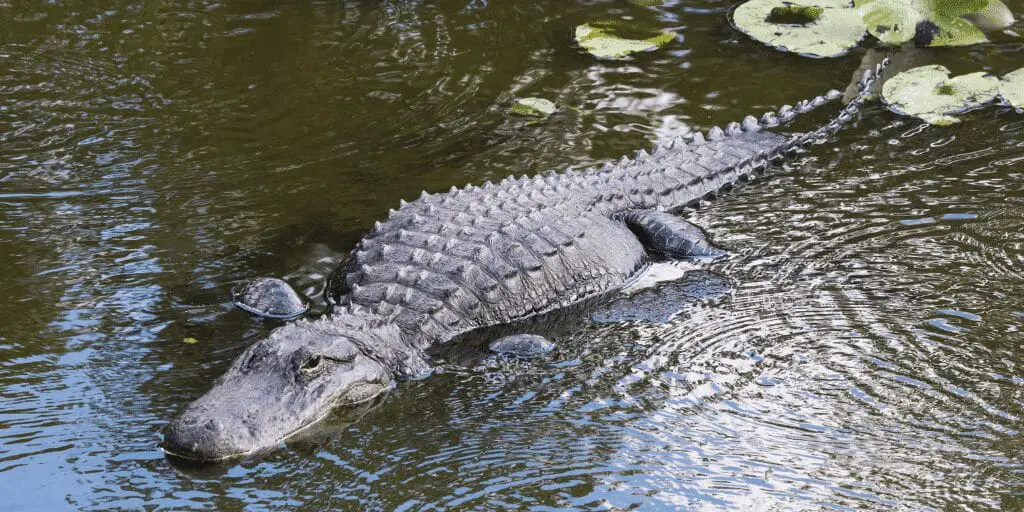
Dive into the fascinating world of reptiles, and you’ll discover a variety of species that have taken to the water with the help of webbed feet. These specialized limbs are not just for ducks and otters; they’re a critical adaptation for several reptiles, enabling them to excel in aquatic environments.
From the formidable alligators and crocodiles to the more unassuming iguanas, each has evolved webbed feet to navigate, hunt, and select habitats effectively. These adaptations are not merely for individual survival; they play a significant role in the health of ecosystems.
As we explore these creatures, we’ll see how they fit into the aquatic food web and why protecting their habitats is vital for the balance of nature.
Alligators: Powerful swimmers with partially to fully webbed hind feet
Imagine an alligator gliding through a swamp, its powerful tail propelling it forward while its webbed hind feet steer and maneuver with surprising agility.
These reptiles are perfectly adapted to their watery realms, with their webbed feet playing a crucial role in their ability to hunt and defend their territory. Alligators can often be seen basking on riverbanks or stealthily swimming in search of prey, their webbed feet allowing them to burst forward with explosive speed when needed.
Alligators are more than just fearsome predators; they are keystone species, essential to the health of wetland ecosystems. By controlling populations of prey such as fish and small mammals, they help maintain a balance in the food web. Their nesting activities also contribute to the environment, as they create depressions that hold water, benefiting a multitude of other species.
The conservation story of the alligator is one of hope. Once on the brink of extinction due to hunting and habitat loss, these reptiles have made a remarkable comeback, thanks to stringent protection measures and habitat conservation efforts. Their recovery highlights the importance of safeguarding the environments they inhabit and fostering a culture of responsible human-wildlife interaction.
Crocodiles are another group of reptiles that have mastered life in and around water. Their webbed feet are not as pronounced as those of other aquatic animals, but they serve an essential purpose, aiding in locomotion through muddy banks and providing stability and propulsion in the water.
Crocodiles are ambush predators, and their webbed feet are part of a suite of adaptations that allow them to approach their prey with stealth and precision.
These ancient reptiles are found in tropical regions around the world, and their presence is a sign of a healthy ecosystem. They help control fish populations and, much like alligators, their nesting behaviors can alter their habitats in ways that benefit other species.
However, crocodiles face numerous threats, including habitat destruction and the illegal skin trade. Conservation efforts are crucial, and they often involve international cooperation to ensure these reptiles can continue to thrive in their natural habitats.
Iguanas: Herbivorous lizards with webbed feet for aquatic propulsion
Not all reptiles with webbed feet are carnivorous hunters. Take the Marine Iguana, for instance, a unique herbivore that forages in the sea. These iguanas have developed webbed feet that enable them to swim efficiently, paddling through the water to graze on algae and other aquatic plants. On land, they are equally adept, using their webbed feet to clamber over rocky terrain and through dense vegetation.
Iguanas are social creatures, often seen basking in groups on the sun-drenched shores of their island habitats. However, they face significant challenges, including habitat loss due to human development, predation by invasive species, and the impacts of climate change, which can alter their food sources and nesting sites.
Protecting the habitats of these adaptable lizards is essential, not only for their survival but for the preservation of the intricate ecosystems they inhabit. Conservation efforts must continue to ensure that iguanas, and the diverse environments they represent, are safeguarded for future generations.
3. Amphibians with Webbed Feet
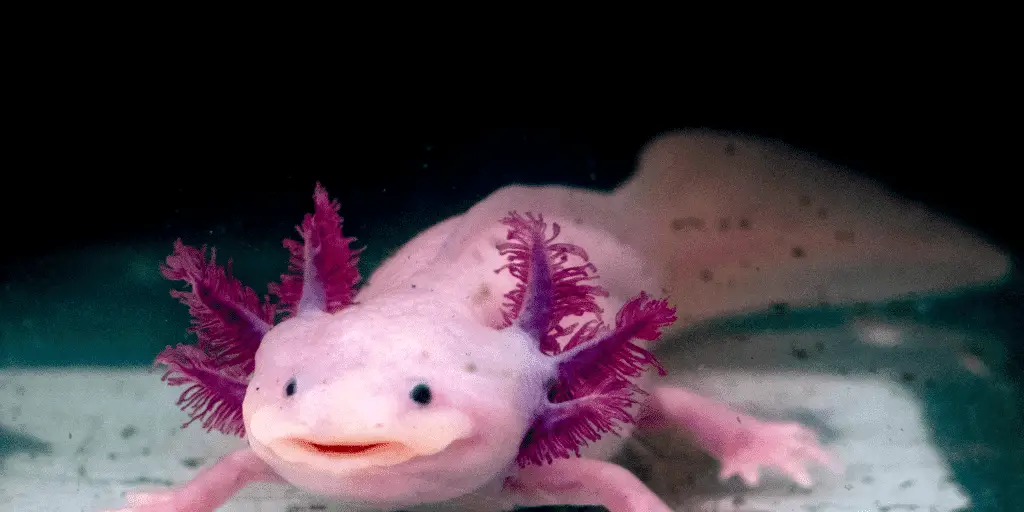
Imagine a world where the boundary between land and water is as thin as a frog’s skin. This is the realm of amphibians, creatures that have mastered the art of living in both environments.
Webbed feet are not just an oddity in this group; they are a critical adaptation that amphibians have evolved to navigate their watery homes with ease. These specialized limbs are not just for paddling through ponds or clinging to slippery rocks; they play a pivotal role in everything from courtship dances to darting away from predators.
As we dive into the lives of axolotls, bullfrogs, common frogs, and Natterjack toads, we’ll uncover how each species uses its webbed feet to thrive in its unique ecological niche.
However, these fascinating creatures are facing an uphill battle against habitat destruction, pollution, and disease. It’s a race against time to implement conservation efforts to safeguard these sensitive indicators of environmental health.
Axolotls: Known as the “Mexican Walking Fish” with underdeveloped webbed feet.
The axolotl, often mistaken for a fish due to its perpetual aquatic lifestyle, is actually an amphibian with a twist. Unlike other amphibians, axolotls do not undergo a complete metamorphosis and retain their larval features, such as gills and underdeveloped webbed feet, throughout their lives.
These unique feet are essential for maneuvering through the canals of Xochimilco, a UNESCO World Heritage site in Mexico, which is the axolotl’s natural habitat. Their webbed feet, along with their otherworldly regenerative abilities, allow them to be efficient swimmers and hunters, gliding through the water to catch worms and small fish.
Sadly, the axolotl is now listed as critically endangered. The pressures of urbanization and water pollution have severely diminished their numbers. Conservationists are working tirelessly to clean up the waters and protect the remaining axolotl population. The axolotl is not just an animal; it’s a scientific marvel, a cultural icon, and a living piece of Mexican heritage that demands urgent conservation action.
American Bullfrogs: Powerful jumpers and swimmers with webbed hind legs.
The American Bullfrog is a testament to the power of webbed feet. These amphibians have evolved webbed hind legs that are not just for show; they are muscular powerhouses that propel bullfrogs in impressive leaps and swift swims.
This ability is crucial for catching prey, which includes a wide array of insects, small mammals, and even other frogs. Bullfrogs are apex predators in their habitats, playing a significant role in maintaining the balance of their ecosystems.
However, their adaptability and voracious appetite have also made them successful invaders. Bullfrogs have been introduced to ecosystems where they have no natural predators, leading to declines in local biodiversity.
Their spread across North America is a concern for conservationists who are striving to manage their populations and mitigate their impact on native species. The bullfrog’s story is a complex one, where the line between a thriving species and an ecological threat is as fine as the webbing between its toes.
Common Frogs: Use webbing for jumping and escaping predators.
The common frog might not have the celebrity status of the axolotl or the notoriety of the bullfrog, but its webbed feet are just as remarkable. These amphibians use their webbing to enhance their jumping prowess and to swim away from threats with surprising agility. Common frogs are found in a variety of habitats, from woodlands to gardens, and are integral in controlling insect populations.
Despite their adaptability, common frogs are not immune to the challenges of a changing world. Habitat destruction, climate change, and disease are constant threats to their populations. Wetland conservation is vital for the survival of these amphibians, as these areas provide crucial breeding grounds and habitats. The common frog may be small, but its impact on the ecosystem is mighty, and its continued existence is a testament to the resilience of nature.
Natterjack Toads: Partially webbed feet aiding in their unique running.
The Natterjack Toad stands out in the amphibian world with its distinctive gait. Unlike their hopping cousins, Natterjack Toads have partially webbed feet that are adapted for a unique running movement.
This adaptation allows them to move quickly across sandy heaths and dunes, their preferred habitats. At night, their powerful mating calls can be heard, a reminder of the vibrancy of nocturnal wildlife.
Natterjack Toads face their own set of challenges, with habitat loss and fragmentation posing significant threats. Conservation measures are in place to protect their breeding sites and ensure the toads have safe corridors to travel between habitats. The Natterjack Toad may not be the most well-known amphibian, but its unique characteristics and ecological role make it an important species for conservation efforts.
4. Mammals with Webbed Feet
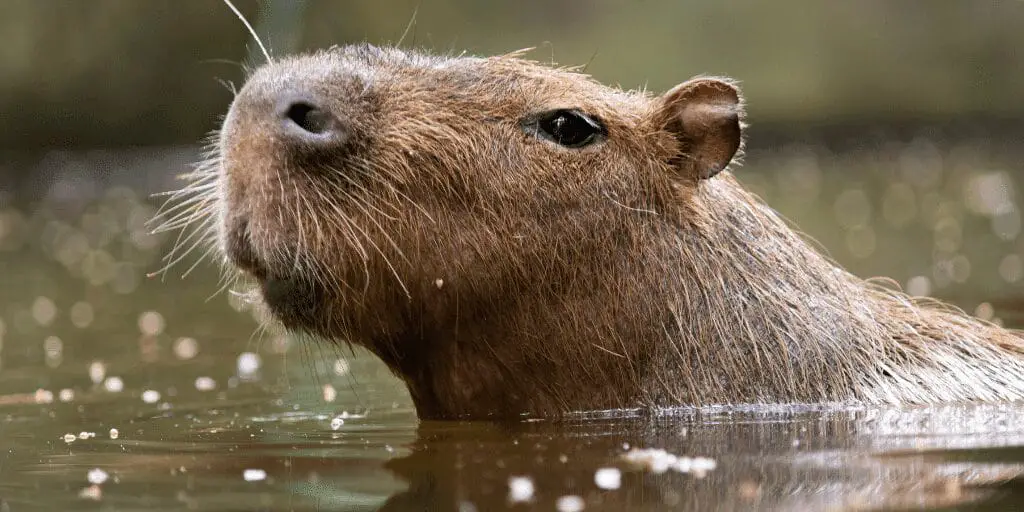
When we think of animals with webbed feet, we often picture ducks and frogs, but a surprising array of mammals also boast this unique adaptation. These mammals have evolved webbed feet to thrive in aquatic environments, showcasing nature’s ingenuity.
From the dense fur of sea otters that allows them to navigate chilly waters to the impressive swimming abilities of polar bears in the Arctic, webbed feet play a crucial role in the hunting, foraging, and survival strategies of these creatures.
However, they face significant conservation challenges, including habitat destruction, climate change, and pollution. Protecting these mammals and their habitats is vital for maintaining the balance of ecosystems where they play integral roles.
Capybaras: The world’s largest rodents, with webbed feet for swimming.
Capybaras are the gentle giants of the rodent world, with their webbed feet making them adept swimmers in the wetlands and rivers they call home. These social creatures live in groups and feed on a plant-based diet, but when danger lurks, their webbed feet are their ticket to safety, propelling them swiftly through the water.
Capybaras are more than just prey for larger predators; they are essential for maintaining the balance of their aquatic ecosystems. Unfortunately, they are threatened by habitat loss and hunting. Conservation efforts are crucial to protect the capybara’s natural habitats and ensure the health of the wetlands.
Eastern Moles: Use webbed feet for digging.
The Eastern Mole might not be the first animal that comes to mind when you think of webbed feet, but this small mammal uses its unique feet to navigate underground. Their webbed feet are like nature’s shovels, allowing them to create extensive tunnel networks.
While often seen as garden nuisances, moles play a critical role in aerating and enriching the soil, which benefits plant life. They face challenges from human activities, such as habitat destruction and pesticide use. Understanding and appreciating their ecological role can lead to more humane and ecologically responsible management practices.
Fishing Cats: Skilled swimmers among wild cats.
Fishing Cats are a testament to the diversity of the feline family, with partially webbed feet that make them exceptional swimmers. These cats are at home in wetland environments, where they hunt for fish and other aquatic prey.
However, their habitats are under threat from degradation, making conservation efforts imperative for their survival. The Fishing Cat’s role in their ecosystems is as unique as their swimming abilities, and preserving wetland habitats is crucial for their continued existence.
Minks: Semi-aquatic with webbed feet for underwater hunting.
Minks are another example of mammals that have adapted to life in and around water. Their webbed feet make them agile hunters, diving for fish and other aquatic creatures. While they face threats from habitat loss, pollution, and the fur trade, there is also the issue of invasive Mink populations in some areas.
Balancing conservation efforts with controlling non-native species is essential to protect local biodiversity and ensure the survival of native species.
Muskrats: Build lodges and swim efficiently with webbed feet.
Muskrats are well-adapted to their aquatic habitats, with webbed feet that aid in building lodges and foraging. They play a significant role in wetland ecosystems, affecting vegetation and water quality.
Muskrats also face challenges from climate change and human development. Protecting and restoring wetland areas are vital for supporting Muskrat populations and the broader ecological community.
Newfoundland Dogs: Bred for water rescue, with strong swimming capabilities.
Newfoundland Dogs are renowned for their swimming abilities, thanks to their webbed feet. Bred for water rescue, these dogs are strong, gentle, and loyal companions. They have played a crucial role in water safety and rescue operations.
Responsible breeding and care are essential for these working dogs, ensuring they have the opportunity to exercise their swimming skills and lead fulfilling lives.
North American Beavers: Use webbed feet for building and swimming.
North American Beavers are nature’s engineers, using their webbed feet to construct dams and lodges. They play a pivotal ecological role, supporting biodiversity and water filtration. Beavers face challenges from land development and human conflict, but there is growing recognition of their importance in ecosystem restoration and climate change mitigation. Coexistence strategies are key to valuing the environmental health and resilience that beaver-engineered landscapes provide.
Opossums: Climbers and swimmers with versatile webbed feet.
Opossums may be known for their climbing abilities, but they are also capable swimmers, thanks to their partially webbed feet. These nocturnal creatures have an omnivorous diet and play a role as scavengers in controlling pests.
They face challenges in urban environments, and increasing appreciation for their adaptability and ecological benefits is important for promoting coexistence with this often misunderstood mammal.
Platypus: Unique among mammals for their egg-laying and webbed feet.
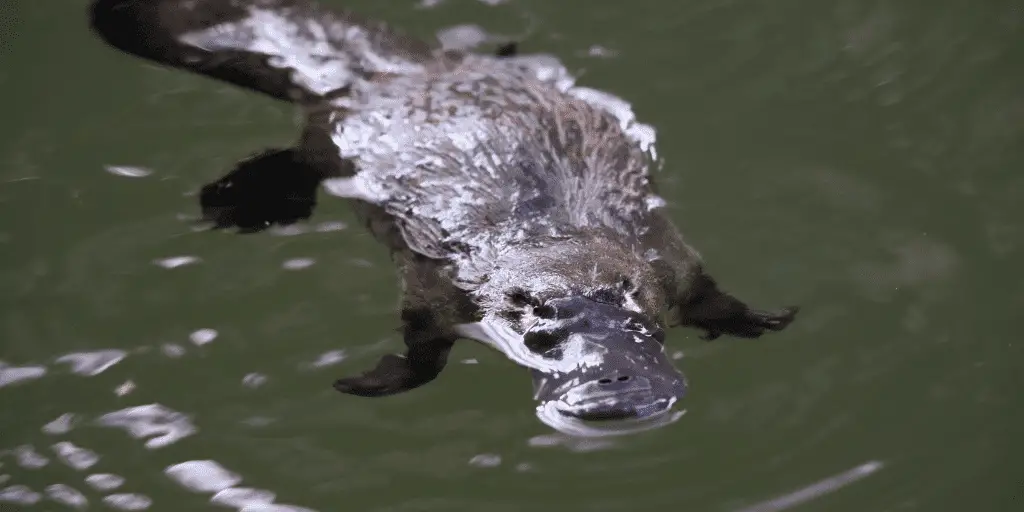
The Platypus is an extraordinary mammal, not only for its egg-laying capabilities but also for its webbed feet, which enhance its swimming and foraging abilities. With electrolocation and a specialized diet, the Platypus is a fascinating creature that relies on clean, flowing waterways. Conservation efforts are critical to protect this iconic Australian mammal and its aquatic habitats.
Polar Bears: Partially webbed feet for skilled swimming.
Polar Bears are the epitome of Arctic survival, with partially webbed feet that aid in their swimming prowess. As the sea ice they depend on for hunting seals diminishes due to climate change, the challenges they face are mounting. Efforts to mitigate climate change are crucial for the survival of Polar Bears and the preservation of the Arctic ecosystem.
Portuguese Water Dogs: Excellent swimmers, historically aiding fishermen.
Portuguese Water Dogs have a storied history of working alongside fishermen, with their webbed feet making them excellent swimmers and retrievers. These intelligent and energetic dogs are well-suited for water activities and require opportunities to swim and exercise. Promoting responsible ownership is key to ensuring these dogs lead active, fulfilling lives.
Sea Otters: Use webbed feet for maneuvering underwater.
Sea Otters are vital to marine ecosystems, using their webbed feet for swimming and foraging. They play a crucial role in maintaining the health of kelp forests and are a conservation success story. Ongoing efforts to protect their habitats from threats like oil spills and climate change are essential for the health of coastal ecosystems.
Conclusion
In conclusion, animals with webbed feet span a diverse range of species, each uniquely adapted to their aquatic or semi-aquatic environments. From the graceful albatross and the swift penguin to the formidable alligator and the playful sea otter, webbed feet serve as a critical evolutionary trait for swimming, hunting, and navigating their habitats.
Birds, reptiles, amphibians, and mammals with webbed feet play vital roles in their ecosystems, contributing to the balance of their respective food webs and the health of the environment. However, many of these species face threats from habitat destruction, climate change, and pollution, underscoring the importance of conservation efforts to protect these remarkable creatures and their habitats.
The resilience and adaptability of webbed-footed animals are a testament to the wonders of nature, and their continued survival is essential for the richness and stability of our planet’s biodiversity.
- What Should I Do If A Koala Bites Me? Safety Guide - 2024-05-30
- Are Kangaroos Born Without Hind Legs? A Fascinating Journey - 2024-05-30
- Animals That Look Like Squirrels - 2024-05-30






